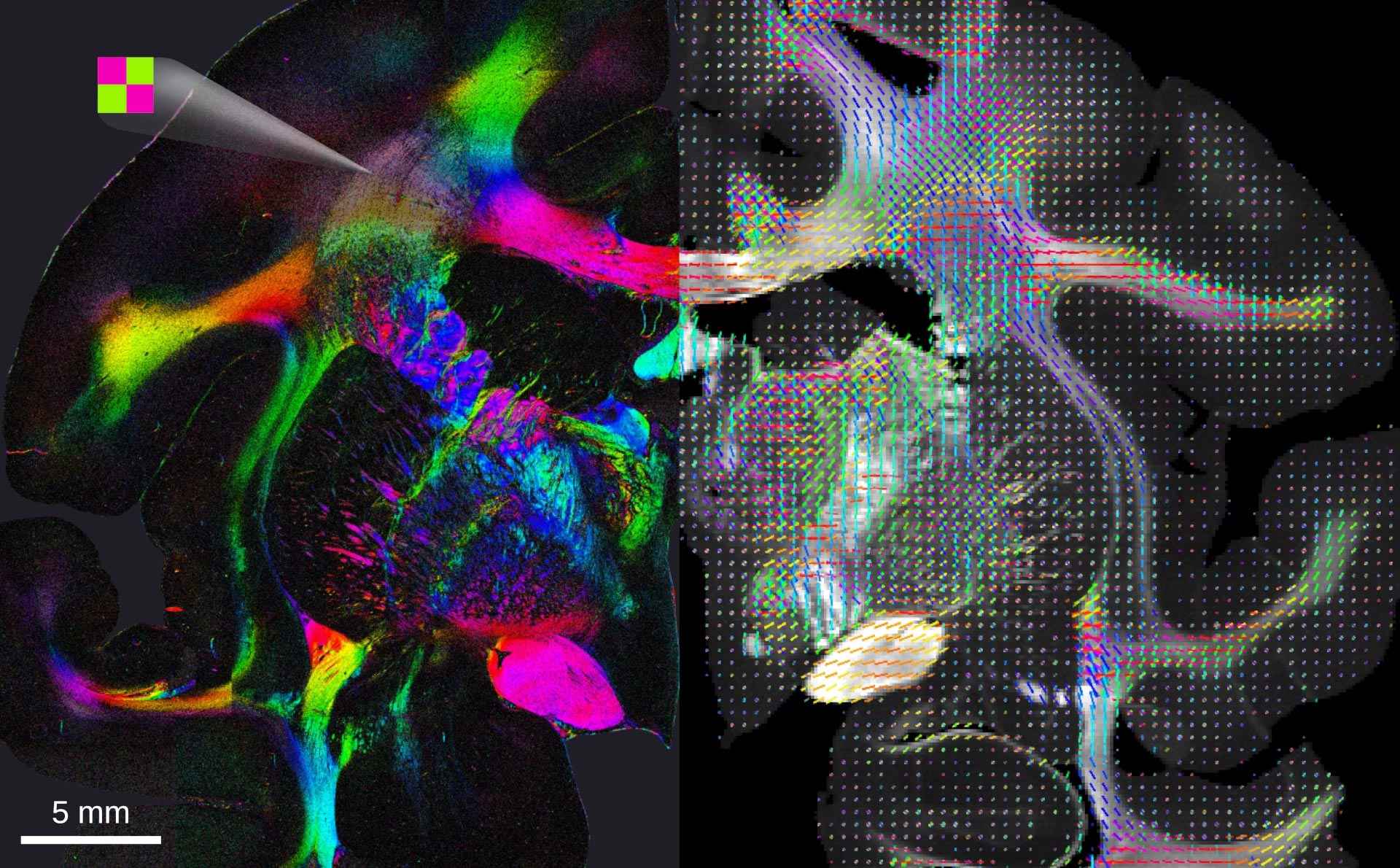
Color-coded nerve fiber directions in brain section obtained from scattering optical imaging (SLI, left) and small angle X-ray scattering (SAXS, right). Credit: TU Delft
Dispersive light imaging (SLI) provides a cost-effective, high-resolution method for mapping neural connections in the brain. This technique, which involves analyzing light scattering patterns in thin slices of the brain, provides more detailed results than current methods such as dMRI, and is more accessible and faster than SAXS.
Untangling the brain’s complex network of nerve fibers is made accessible with scattering optical imaging (SLI): researchers at Delft and Julich (Germany) and Stanford (USA) have successfully combined X-ray light scattering with MRI to characterize nerve fiber pathways , as well as in areas with highly intertwined fibers. SLI revealed tracks in the smallest detail, while being much faster and cheaper than X-ray and MRI techniques. This detailed mapping is essential for a better understanding of how nerve fibers are connected within the brain.
pathways in the brain
Different regions of the brain are connected to each other by billions of nerve fibres. These connections are essential for proper brain function. The search for a comprehensive map of all nerve connections depends crucially on imaging techniques that can unravel these fibers, most of which are only a micrometer thick. Areas with very dense, intertwined nerve fibers present a particular challenge. Miriam Menzel, assistant professor in the Department of Imaging Physics at TU Delft, developed the SLI technique to study such fibril constellations: “We shine light under different angles through hair-thin brain slices and analyze the resulting scattering patterns. We don’t take a picture of neurons or synapses. We want to know how they are wired. This is important for understanding brain function and dysfunction.”
More accessible, cheaper and faster
Small-angle X-ray scattering (SAXS) is a well-established method in materials science for looking at how different structures are organized using the synchrotron, while diffusion magnetic resonance imaging (dMRI) is an important technique in clinics for visualizing the three-dimensional nerve fiber network in the brain. “We have now shown that SLI data is consistent with that from SAXS and dMRI in the brain slices examined, but SLI provides higher resolution than dMRI and is more accessible, cheaper, and faster than other techniques. This is an important milestone,” says Menzel. We can perform SLI measurements with a simple LED light source and a camera in just a few seconds, and it requires neither a million synchrotron scanner nor an MRI scanner. As a portable system, it can easily be placed in pathology laboratories to aid clinical research.”
microscopic resolution
Menzel has spent the past few years working on SLI technology, first in Jülich and now in Delft. She also carried it out at Stanford, where her fellow researchers performed SAXS and dMRI measurements on brain samples that were also imaged using SLI. “Most imaging techniques struggle to distinguish individual pathways in dense brain structures that contain many intertwined or tangled nerve fibers,” explains Menzel. “SLI provided fiber orientation maps at microscopic resolution in these dense regions.” Particularly 2D (“inner”) fiber directions were characterized at high resolution.
next steps
“Being in Delft offers exciting opportunities to develop the technology further and work on new applications,” says Menzel. The team also plans to apply SLI to other types of fibres, such as muscle and collagen fibers, and to expand the area of tissue that can be studied. The goal is to develop a small and portable system that can be easily deployed in other laboratories. “In the long term, we hope to implement this technology in clinics as well.”
Reference: “Using Light Scattering and X-Rays to Untangle Complex Neural Directions and Validate Diffusion MRI” By Miriam Menzel, David Grisel, Ivan Rajkovic, Michael M. Zenh, Marius Georgiadis May 11, 2023, Available Here. eLife.
DOI: 10.7554/eLife.84024

“Typical beer advocate. Future teen idol. Unapologetic tv practitioner. Music trailblazer.”







More Stories
Boeing May Not Be Able to Operate Starliner Before Space Station Is Destroyed
How did black holes get so big and so fast? The answer lies in the darkness
UNC student to become youngest woman to cross space on Blue Origin